- Electric and Telecom Plans Free
- Fire and Emergency Plans Free
- Floor Plans Free
- Plant Layout Plans Free
- School and Training Plans Free
- Seating Plans Free
- Security and Access Plans Free
- Site Plans Free
- Sport Field Plans Free
- Business Process Diagrams Free
- Business Process Mapping Free
- Classic Business Process Modeling Free
- Cross-Functional Flowcharts Free
- Event-driven Process Chain Diagrams Free
- IDEF Business Process Diagrams Free
- Logistics Flow Charts Free
- Workflow Diagrams Free
- ConceptDraw Dashboard for Facebook Free
- Mind Map Exchange Free
- MindTweet Free
- Note Exchange Free
- Project Exchange Free
- Social Media Response Free
- Active Directory Diagrams Free
- AWS Architecture Diagrams Free
- Azure Architecture Free
- Cisco Network Diagrams Free
- Cisco Networking Free
- Cloud Computing Diagrams Free
- Computer Network Diagrams Free
- Google Cloud Platform Free
- Interactive Voice Response Diagrams Free
- Network Layout Floor Plans Free
- Network Security Diagrams Free
- Rack Diagrams Free
- Telecommunication Network Diagrams Free
- Vehicular Networking Free
- Wireless Networks Free
- Comparison Dashboard Free
- Composition Dashboard Free
- Correlation Dashboard Free
- Frequency Distribution Dashboard Free
- Meter Dashboard Free
- Spatial Dashboard Free
- Status Dashboard Free
- Time Series Dashboard Free
- Basic Circle-Spoke Diagrams Free
- Basic Circular Arrows Diagrams Free
- Basic Venn Diagrams Free
- Block Diagrams Free
- Concept Maps Free
- Family Tree Free
- Flowcharts Free
- Basic Area Charts Free
- Basic Bar Graphs Free
- Basic Divided Bar Diagrams Free
- Basic Histograms Free
- Basic Line Graphs Free
- Basic Picture Graphs Free
- Basic Pie Charts Free
- Basic Scatter Diagrams Free
- Aerospace and Transport Free
- Artwork Free
- Audio, Video, Media Free
- Business and Finance Free
- Computers and Communications Free
- Holiday Free
- Manufacturing and Maintenance Free
- Nature Free
- People Free
- Presentation Clipart Free
- Safety and Security Free
- Analog Electronics Free
- Audio and Video Connectors Free
- Basic Circuit Diagrams Free
- Chemical and Process Engineering Free
- Digital Electronics Free
- Electrical Engineering Free
- Electron Tube Circuits Free
- Electronic Block Diagrams Free
- Fault Tree Analysis Diagrams Free
- GHS Hazard Pictograms Free
- Home Automation and Wiring Free
- Mechanical Engineering Free
- One-line Diagrams Free
- Power Сircuits Free
- Specification and Description Language (SDL) Free
- Telecom and AV Circuits Free
- Transport Hazard Pictograms Free
- Data-driven Infographics Free
- Pictorial Infographics Free
- Spatial Infographics Free
- Typography Infographics Free
- Calendars Free
- Decision Making Free
- Enterprise Architecture Diagrams Free
- Fishbone Diagrams Free
- Organizational Charts Free
- Plan-Do-Check-Act (PDCA) Free
- Seven Management and Planning Tools Free
- SWOT and TOWS Matrix Diagrams Free
- Timeline Diagrams Free
- HR Flowcharts $25
- Australia Map Free
- Continent Maps Free
- Directional Maps Free
- Germany Map Free
- Metro Map Free
- UK Map Free
- USA Maps Free
- Customer Journey Mapping Free
- Marketing Diagrams Free
- Matrices Free
- Pyramid Diagrams Free
- Sales Dashboard Free
- Sales Flowcharts Free
- Target and Circular Diagrams Free
- Cash Flow Reports Free
- Current Activities Reports Free
- Custom Excel Report Free
- Knowledge Reports Free
- MINDMAP Reports Free
- Overview Reports Free
- PM Agile Free
- PM Dashboards Free
- PM Docs Free
- PM Easy Free
- PM Meetings Free
- PM Planning Free
- PM Presentations Free
- PM Response Free
- Resource Usage Reports Free
- Visual Reports Free
- House of Quality Free
- Quality Mind Map Free
- Total Quality Management TQM Diagrams Free
- Value Stream Mapping Free
- Astronomy Free
- Biology Free
- Chemistry Free
- Language Learning Free
- Mathematics Free
- Physics Free
- Piano Sheet Music Free
- Android User Interface Free
- Class Hierarchy Tree Free
- Data Flow Diagrams (DFD) Free
- DOM Tree Free
- Entity-Relationship Diagram (ERD) Free
- EXPRESS-G data Modeling Diagram Free
- IDEF0 Diagrams Free
- iPhone User Interface Free
- Jackson Structured Programming (JSP) Diagrams Free
- macOS User Interface Free
- Object-Role Modeling (ORM) Diagrams Free
- Rapid UML Free
- SYSML Free
- Website Wireframe Free
- Windows 10 User Interface Free
HR Flowcharts
Human resources are those who make up the workforce of some particular organization, economy or business sector. The "human capital" term may be understood as a synonym to the "human resources’" one. But at the same time, “human capital” one usually refers to a narrower view such as the knowledge the individuals embody as well as the economic growth. Some other terms that can sometimes be used in place of “human resources” include “talent”, “manpower”, “labor”, “people”, or “personnel”.
Any human-resources, or HR, department of some organization is expected to perform human resource management, overseeing different aspects of employment (e.g., compliance with labor law and some of the employment standards), some aspects of dismissal and recruitment, as well as administration of employee benefits.
It is known that any HR manager is responsible for identifying work-related needs of staff, using temporary staff or hiring employees to meet such needs, recruiting and training the best employees, monitoring their work, managing relationships with employees, payroll, benefits and compensation, preparing personal policies and employee records, ensuring high efficiency, ensuring equal opportunities for all employees, dealing with discrimination and other performance issues. Ensuring that human resources practices conform to the regulations and pushing the employees' motivation so they achieve more within their organization, HR managers might find the ConceptDraw DIAGRAM software a useful tool for making the needed HR-related drawings.
The HR Flowcharts solution is ideal for using while creating the HR-related drawings in the ConceptDraw DIAGRAM charting and drawing software, providing with a comprehensive collection of human resources themed icons, connectors, and images from the available stencil libraries, helping illustrating flowcharts, infographics and workflow diagrams.
Using this solution for mapping the HR-related management processes on every phase of human resource management, including the hiring process, the process of recruitment, payroll systems and human resource development, the HR managers, same as many other managers, such as the project ones, may achieve more in their work spending less time on their tasks.
-
Buy this solution $25 -
Solution Requirements - This solution requires the following products to be installed:
ConceptDraw DIAGRAM v18 - This solution requires the following products to be installed:
-
Compatibility - Sonoma (14), Sonoma (15)
MS Windows 10, 11 - Sonoma (14), Sonoma (15)
-
Support for this Solution -
Helpdesk
The HR Flowcharts solution contains 10 examples and 7 libraries containing 387 vector graphics and icons.
Design Elements — HR Department
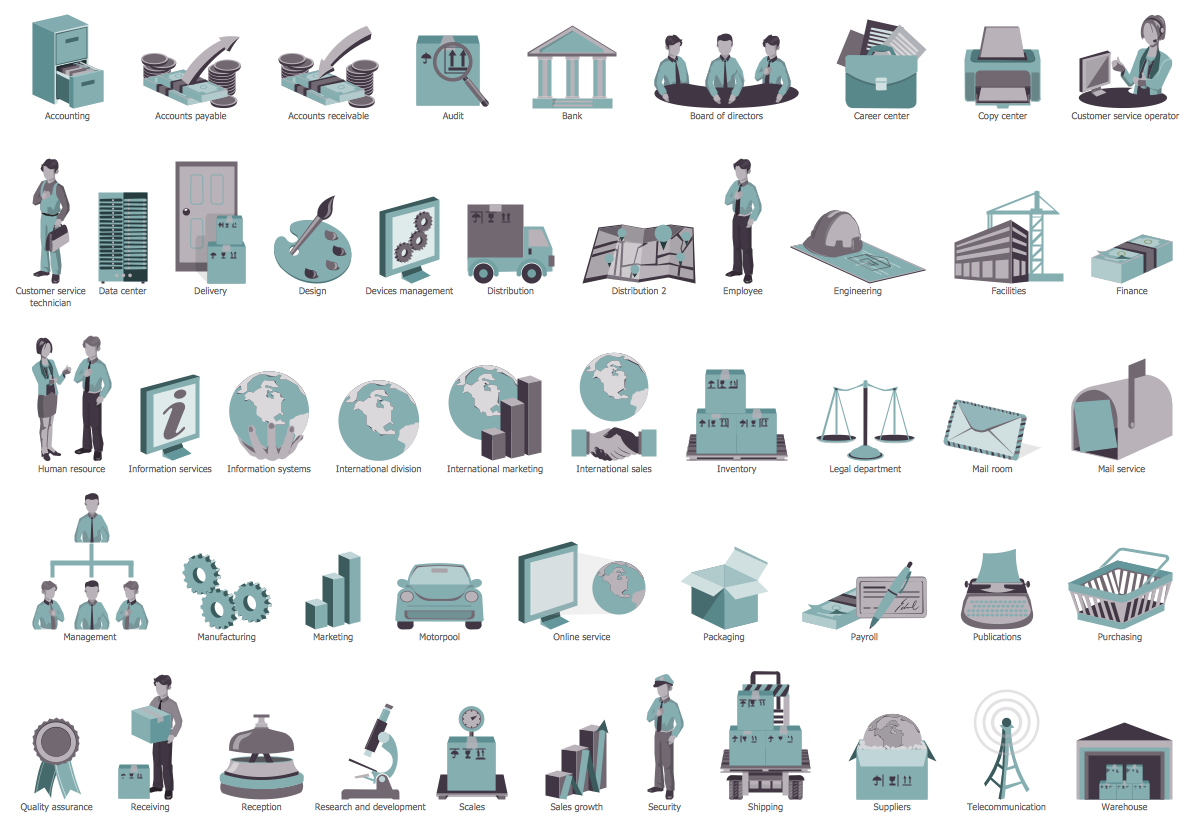
Design Elements — HR Professions
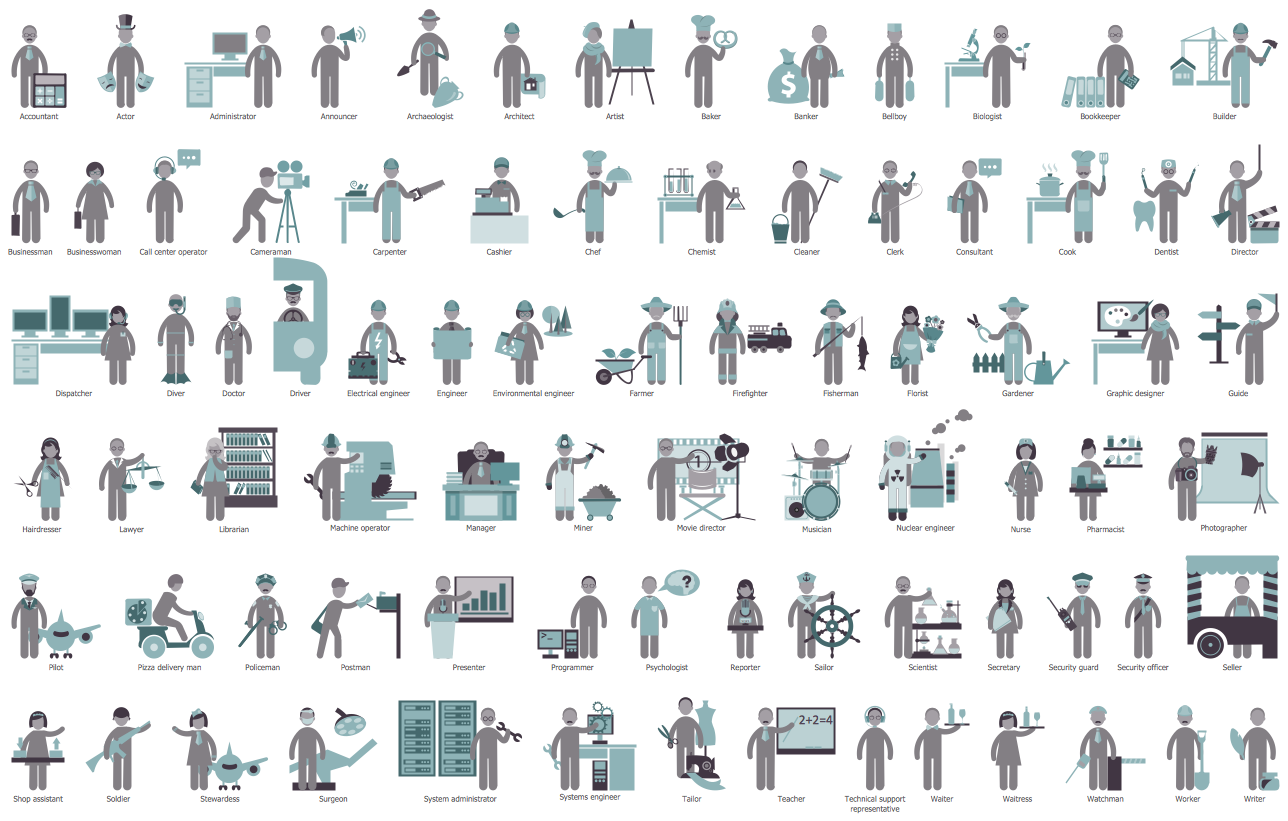
Design Elements — HR Steps
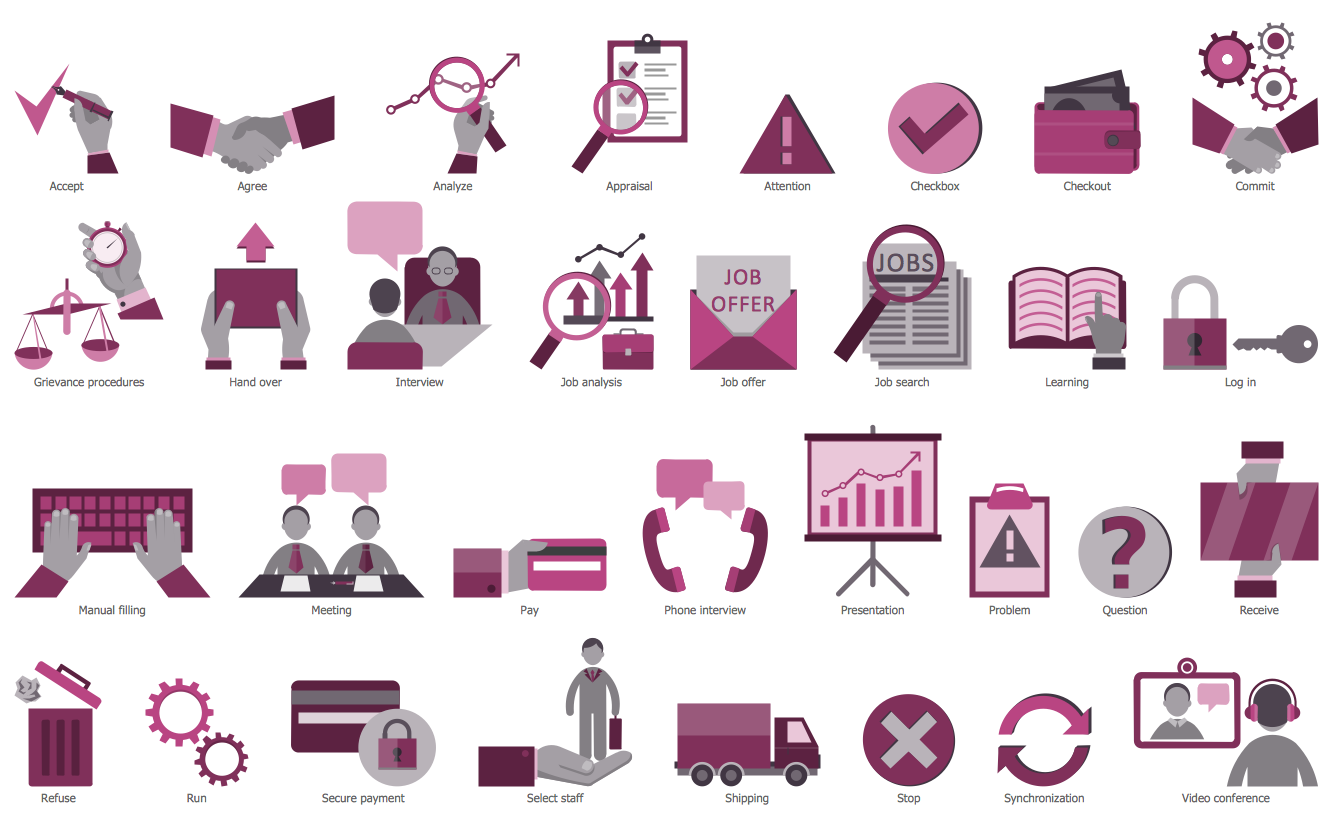
Design Elements — HR Symbols
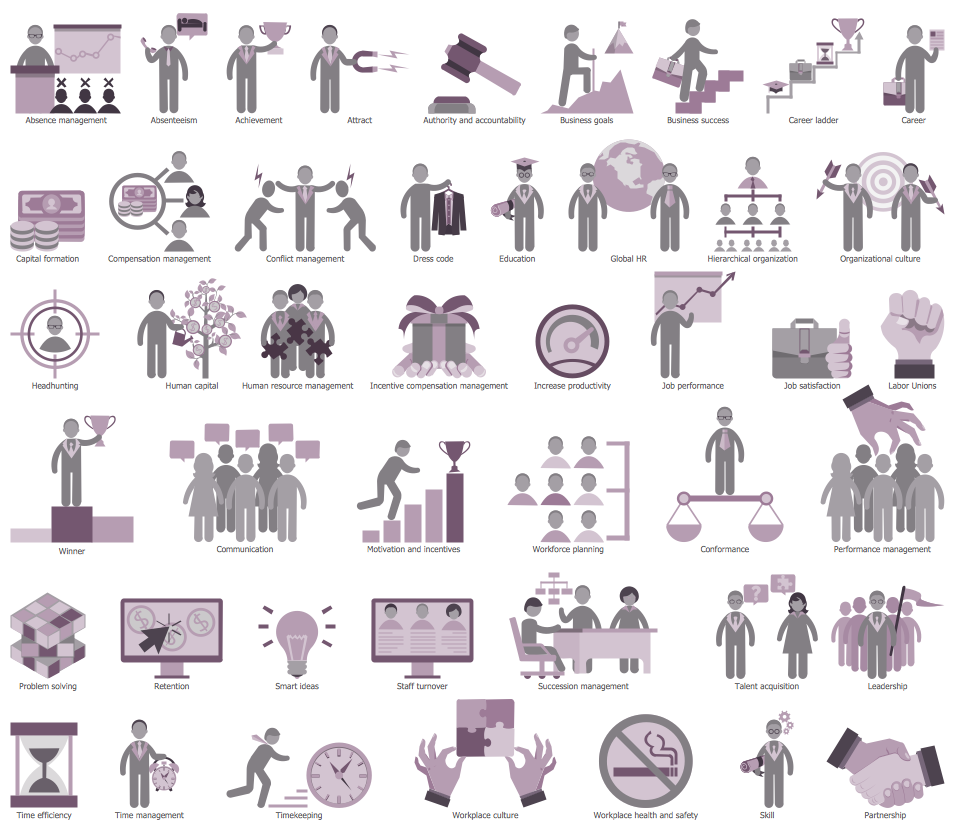
Design Elements — HR Workflow
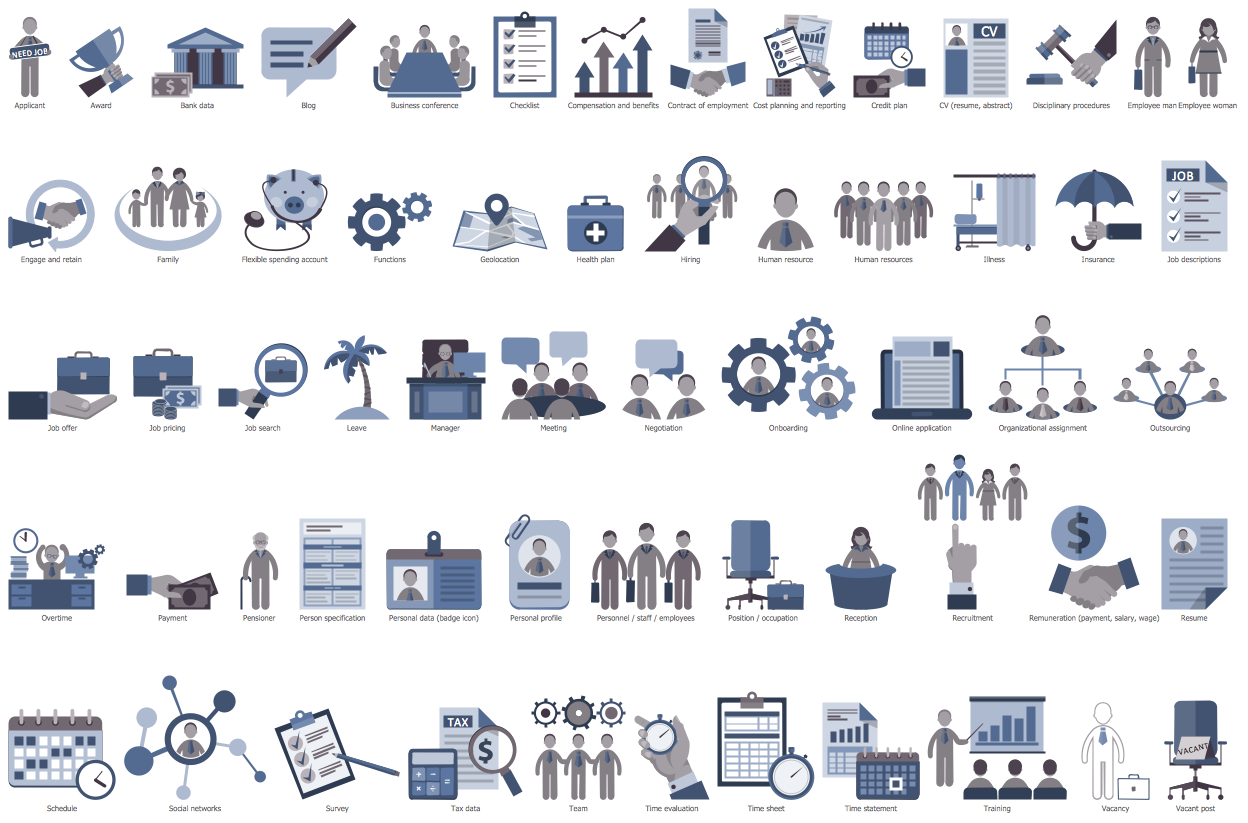
Design Elements — HR Flowchart

Design Elements — HR Arrows

HR Flowcharts Examples
There are a few samples that you see on this page which were created in the ConceptDraw DIAGRAM application by using the HR Flowcharts solution. Some of the solution's capabilities as well as the professional results which you can achieve are all demonstrated here on this page.
All source documents are vector graphic documents which are always available for modifying, reviewing and/or converting to many different formats, such as MS PowerPoint, PDF file, MS Visio, and many other graphic ones from the ConceptDraw Solution Park or ConceptDraw STORE. The HR Flowcharts solution is available to all ConceptDraw DIAGRAM users to get installed and used while working in the ConceptDraw DIAGRAM charting and drawing software.
Example 1: Human Resource Management — Competency Based Management
This diagram was created in ConceptDraw DIAGRAM using HR Symbols and HR Arrows libraries from HR Flowcharts solution. An experienced user spent 10 minutes creating this sample.
This diagram illustrates the foundation of competency-based human resource management (HRM) and all the processes that come within the HRM circle of competency. It was redesigned from the “Competency-circle.jpg” file published on the Wikimedia Commons. The competencies are specified as knowledge, skills, abilities, behavior, and motivations required for successful job performance. The competency-based human resource planning is a link between the organization’s strategic plan and human resources management. It supports the unification of human resources planning and business planning, and allows you to effectively assess the capacity of the staff based on its personal competence and potential required to achieve the company’s business goals. The human resource strategies, plans, and programs are developed and implemented to close the gaps. As you can see from the diagram, there is a lot of work included in a competency-based HRM, but the ConceptDraw DIAGRAM can simplify the process through the HR Flowcharts solution.

Example 2: Electronic Human Resources
This diagram was created in ConceptDraw DIAGRAM using HR Department and HR Flowchart libraries from HR Flowcharts solution. An experienced user spent 10 minutes creating this sample.
The human resources management doesn't involve just people working at the company or organization, but also department responsible for managing these people, as well as the electronic and software processes associated with HR. E-HR is the interaction of human resources with information technologies. It is a function of HR, which is closely linked with the use of electronic information, electronic devices, databases, and newest information technologies, with management and regulation the information processes within the organization. This diagram was created in ConceptDraw DIAGRAM software based on Wikimedia Commons file "Ehr diagram.jpg" and shows the set of common electronic and software technologies and processes connected with human resources management, among them there are: database management, data theft, e-discovery, ISF, telepresence, employee monitoring, case law, cloud computing, and electronic processes. The large selection of vector clipart available in the solution libraries allows you to illustrate all the processes with the appropriate graphics.

Example 3: Human Resource Development — Onboarding Model
This diagram was created in ConceptDraw DIAGRAM using HR Symbols and HR Arrows libraries from HR Flowcharts solution. An experienced user spent 15 minutes creating this sample.
This sample shows the effectiveness of clean and straight lines with well-spaced subject areas. Being based on the Wikimedia Commons file, it promotes the human resource development and charts the onboarding (organizational socialization) model, the process of integration used between new employees and the workforce. The onboarding process is a set of mechanisms and methodologies the application of which lets new employees acquire the required skills, knowledge, and behaviors to become effective and in demand members of a certain organization or company. The socialization tactics and techniques have a huge positive impact on new employees, they contribute to better productivity, increasing the interest and ability to work, enhancing job satisfaction, and eliminating stress elements. All these results are achievable with the help of listed tactics, efforts, and adjustments, and are incredibly important for all organizations and companies striving to succeed, to achievement and maintenance a leading position on the market in a highly competitive environment.
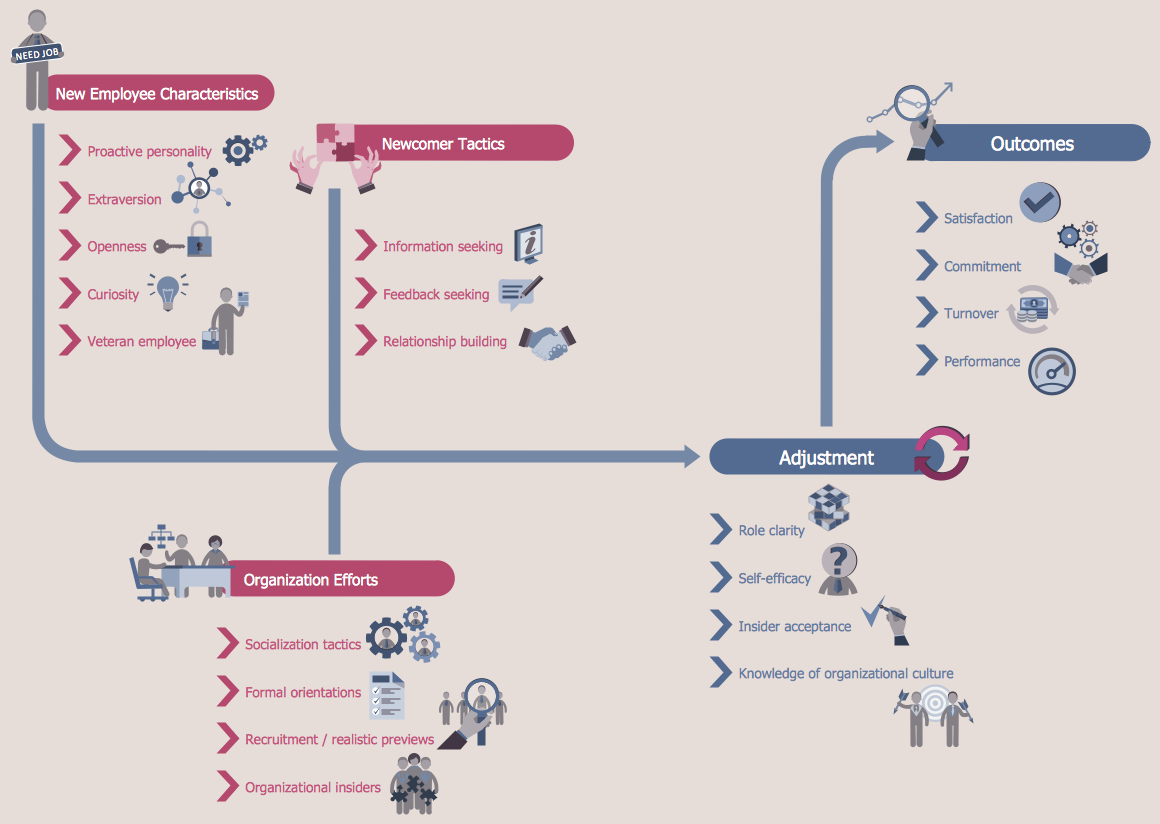
Example 4: Human Resources Flowchart — Talent Management Process
This diagram was created in ConceptDraw DIAGRAM using HR Workflow and HR Arrows libraries from HR Flowcharts solution. An experienced user spent 15 minutes creating this sample.
This HR flowchart demonstrates the talent management process. It is a strategic human resource management process directed on the increasing the company's success and improving business by means of effective business strategy combined with the strategic workforce planning, and human resources recruitment, retaining, developing, and rewarding. A variety of diagram types is available for construction in ConceptDraw DIAGRAM software, a lot of diagrams' prebuilt shapes are included, and when you have a process that is repeated, such as a hiring process, you can choose a circle flowchart that is the ideal method to visualize this. The represented HR infographic is based on the Wikimedia Commons file "Model_TM.jpg" and illustrates in detail the step-by-step process of the talent management, which includes the workforce planning, recruiting, organizational socialization (onboarding), performance management, training and performance support, succession planning, compensation and benefits, critical skills gap analysis steps. Besides, all steps are illustrated with pre-made visual clipart.

Example 5: Human Resources Flowchart — UK Labour Market Categories
This diagram was created in ConceptDraw DIAGRAM using HR Flowcharts and HR Professions libraries from HR Flowcharts solution. An experienced user spent 20 minutes creating this sample.
This sample created on the base of the Wikipedia file "UK Labour Market Categories.png" represents the standardized notation form of flowchart that is most commonly used. It demonstrates the UK labour market categories and the kind of questions that any worker must answer to make themselves ready for recruitment. The employer hires employees to perform certain functions, to provide services to the company on a regular basis in exchange for payment. At this, the employee must have certain knowledge, qualification, and skills that are determined at the moment of the interview with the employer. So, the moment of recruitment is really important for both employer and future employee. As can be seen from the flowchart, the first question for the hired person is about his age, and only if the candidate's age is over 16, he can be included to UK labour market statistics and his testing proceeds. The HR icons and symbols used in this flowchart serve to emphasize the steps and decisions.

Example 6: Human Resources Flowchart — Recruitment Model
This diagram was created in ConceptDraw DIAGRAM using HR Flowcharts and HR Professions libraries from HR Flowcharts solution. An experienced user spent 15 minutes creating this sample.
This sample diagram demonstrates the recruitment model. It was designed on the base of the illustration from the article "Better, Faster: streamlining recruitment in the APS" published on the Australian Public Service Commission website. The recruitment process provides all circle of activities from the attracting candidates, selecting and shortlisting them, to the appointing the suitable ones for defined positions within an organization. It is a really responsible process, from which the results of implemented projects, the company's profits, and its overall success largely depend on. Therefore, it is desired that this process will be realized not by the ordinary managers, but the HR experts, HR specialists, or HR managers working within a company or specially invited from outside, from the commercial recruitment agencies. The offered model illustrates three clear lines of responsibility. The corporate standards, accountabilities, recruitment performance and quality standards are set at the organization level. HR provides information, structure, and support, and the managers plan and manage the processes.
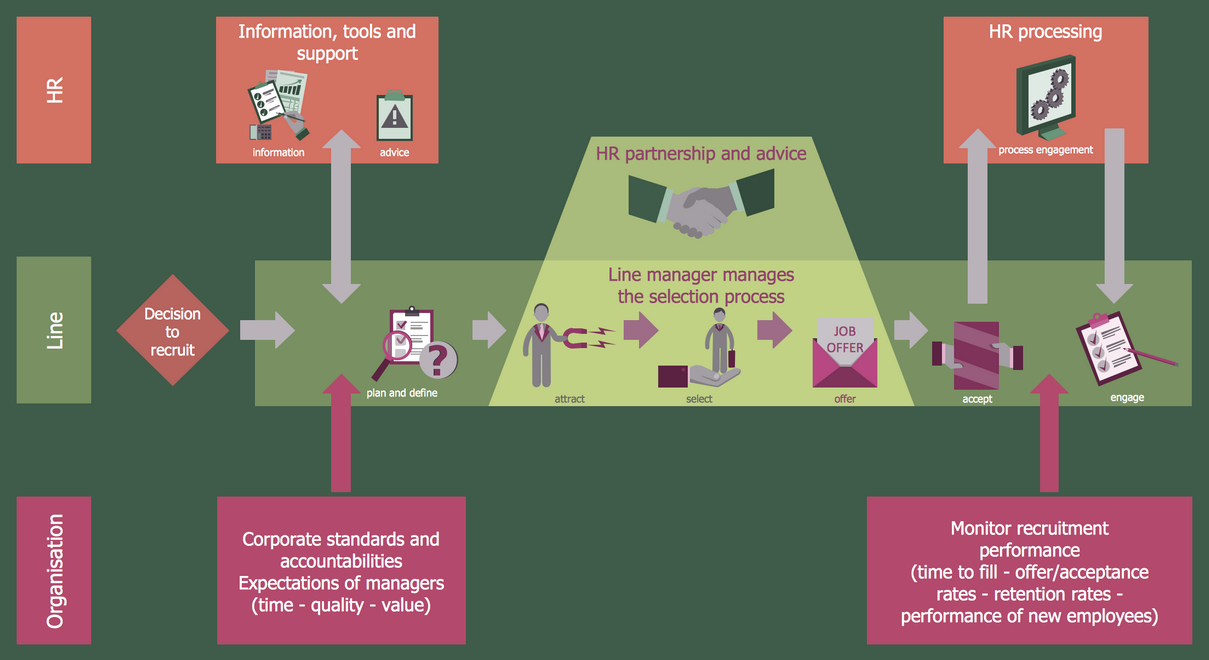
Example 7: Human Resources Flowchart — Hiring Process
This diagram was created in ConceptDraw DIAGRAM using HR Flowcharts and HR Professions libraries from HR Flowcharts solution. An experienced user spent 10 minutes creating this sample.
This HR infographics example illustrates the hiring process of candidates to the vacant position. It was constructed in ConceptDraw DIAGRAM based on the "Hiring Process" flowchart from the Idaho Division of Human Resources website. This sample is a flowchart outlining the steps needed to be performed to fill a vacant position at the company. The key points are easily noticeable from the diagram, these are the hiring list containing the names of applicants who passed the examination for a vacant position, announcement of a vacant position, the conducting of lawful employment interview with the candidate to determine his suitability for an available position, checking his references with a goal to choose the best one from the several suitable candidates, then offering a job for the selected candidate, also performing verification in the internet based E-Verify system, filling the hire paperwork by new employee, and finally passing the probationary period of working on the offered position.
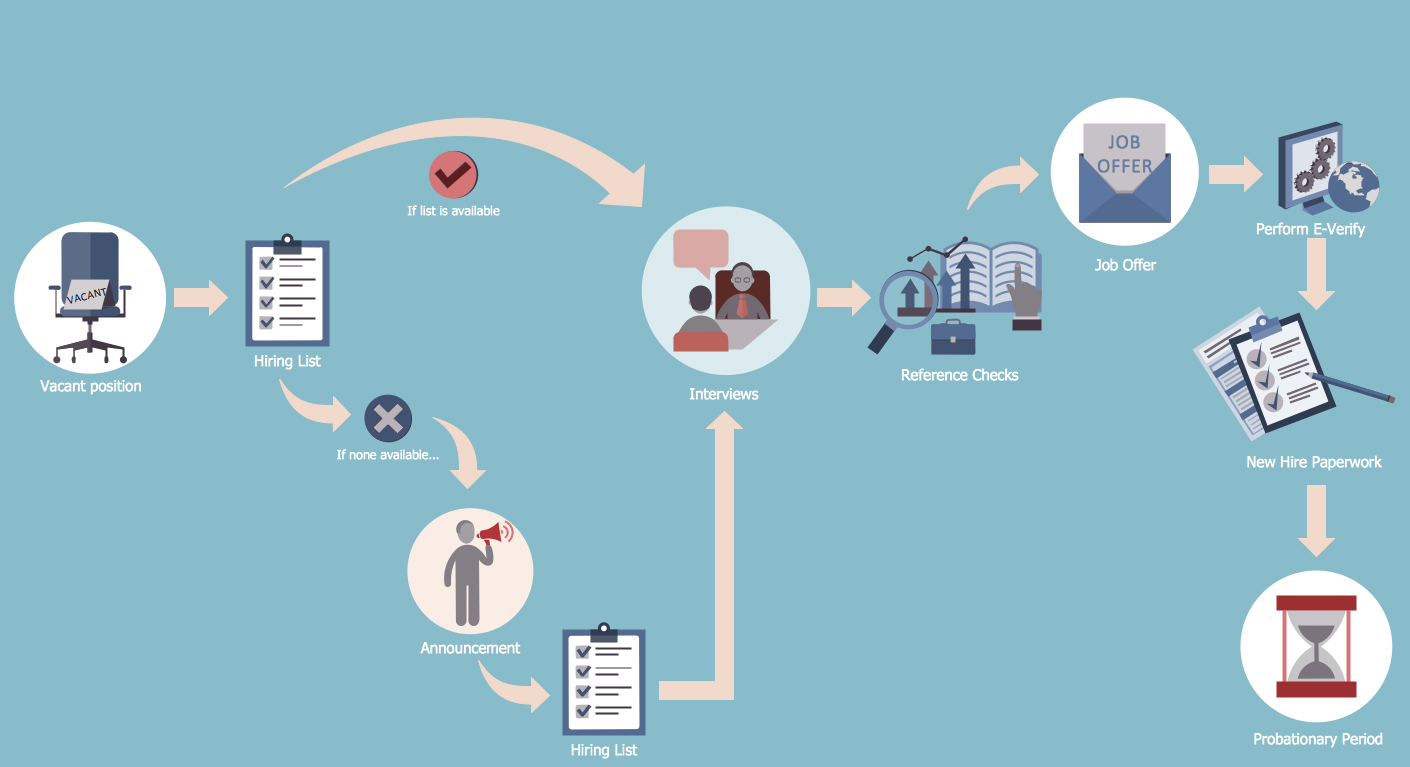
Example 8: Investment and Construction Application Procedures
This diagram was created in ConceptDraw DIAGRAM using HR Flowcharts and HR Professions libraries from HR Flowcharts solution. An experienced user spent 15 minutes creating this sample.
This HR diagram is an example of business infographics that visually describes the steps of procedures of the investment and construction in the form of a flowchart. Being based on the "Establishing Operations in an Environmental Protection Park" flowchart published on the website of the Ministry of Economic Affairs and Taiwan Department of Investment Services, it is now redesigned in ConceptDraw DIAGRAM vector graphics software using the powerful tools of HR Flowcharts solution and the ready-made clipart objects from the solution's libraries. These investment and construction application procedures were officially prescribed by the Preparatory Office of ESTP in Southern Taiwan. The application and strict compliance the sequence of these steps execution is a mandatory condition of registration of the company and obtaining a permit for investment of foreign capital to the construction in Taiwan. The period of obtaining permission from the submission date is sufficiently long and takes approximately two months.

Example 9: Human Resources Flowchart — Foreign Labor Certification Workflow
This diagram was created in ConceptDraw DIAGRAM using HR Flowcharts and HR Professions libraries from HR Flowcharts solution. An experienced user spent 10 minutes creating this sample.
This Human Resources diagram sample represents the workflow chart describing the process of foreign labor certification. It was constructed based on the workflow diagram published on the webpage "About Foreign Labor Certification" of the U.S. Department of Labor website. The procedure of hiring the foreign workers in the USA includes an obligatory approval of several government agencies. The list of requirements that need to be completed by the employer to obtain the labor certification is approved. Primarily, the employer needs to ensure that the vacancy meets the qualifying criteria of the selected foreign labor certification program, then it must complete the appropriate ETA Form for the program requested and ensure that the candidate will be paid of least the prevailing wage rate. Besides, when the employer signs the ETA Form, it must ensure that all employer compliances are completely understood. At last, the completed ETA Form and all required attachments are mailed to the designated office.
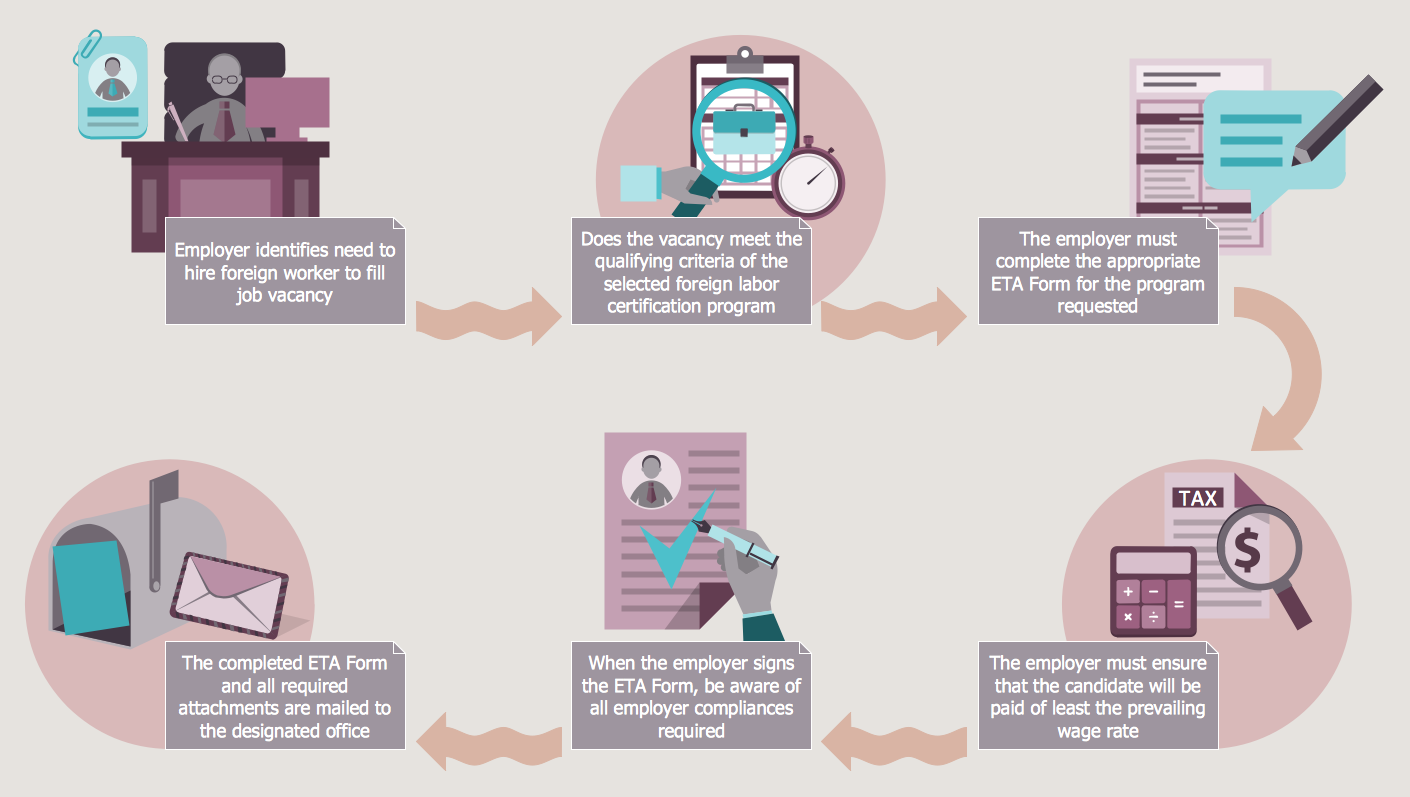
Example 10: Post Employment Committee Recruitment Flowchart
This diagram was created in ConceptDraw DIAGRAM using HR Flowcharts and HR Professions libraries from HR Flowcharts solution. An experienced user spent 20 minutes creating this sample.
This HR flowchart sample depicts the recruitment process realized by the Post Employment Committee (PEC). It is a cross-functional flowchart that was designed based on the files from the Wikimedia Commons. The Post Employment Committee (PEC) provides the proper application of the US Citizen EFM and US Veterans Hiring Preference. This flowchart includes the set of process steps that are consistently connected by the arrows demonstrating the order of operations. The different shapes have different coloring, even the shapes representing Yes and No variants are colored differently for the great clarity. The flowchart swimlanes also have different backgrounds but in color harmony with each other. You can observe five swimlanes on this diagram: customer (supervisor), management officer (agency rep), HR office, applicant, and MED & RSO (DS). The process steps are placed at the appropriate lanes, at this, you need to avoid a lot of crisscrossing of the flow lines.

Inside


What I Need to Get Started
After ConceptDraw DIAGRAM is installed, the HR Flowcharts solution can be purchased either from the Management area of ConceptDraw STORE itself or from our online store. Thus, you will be able to use the HR Flowcharts solution straight after.
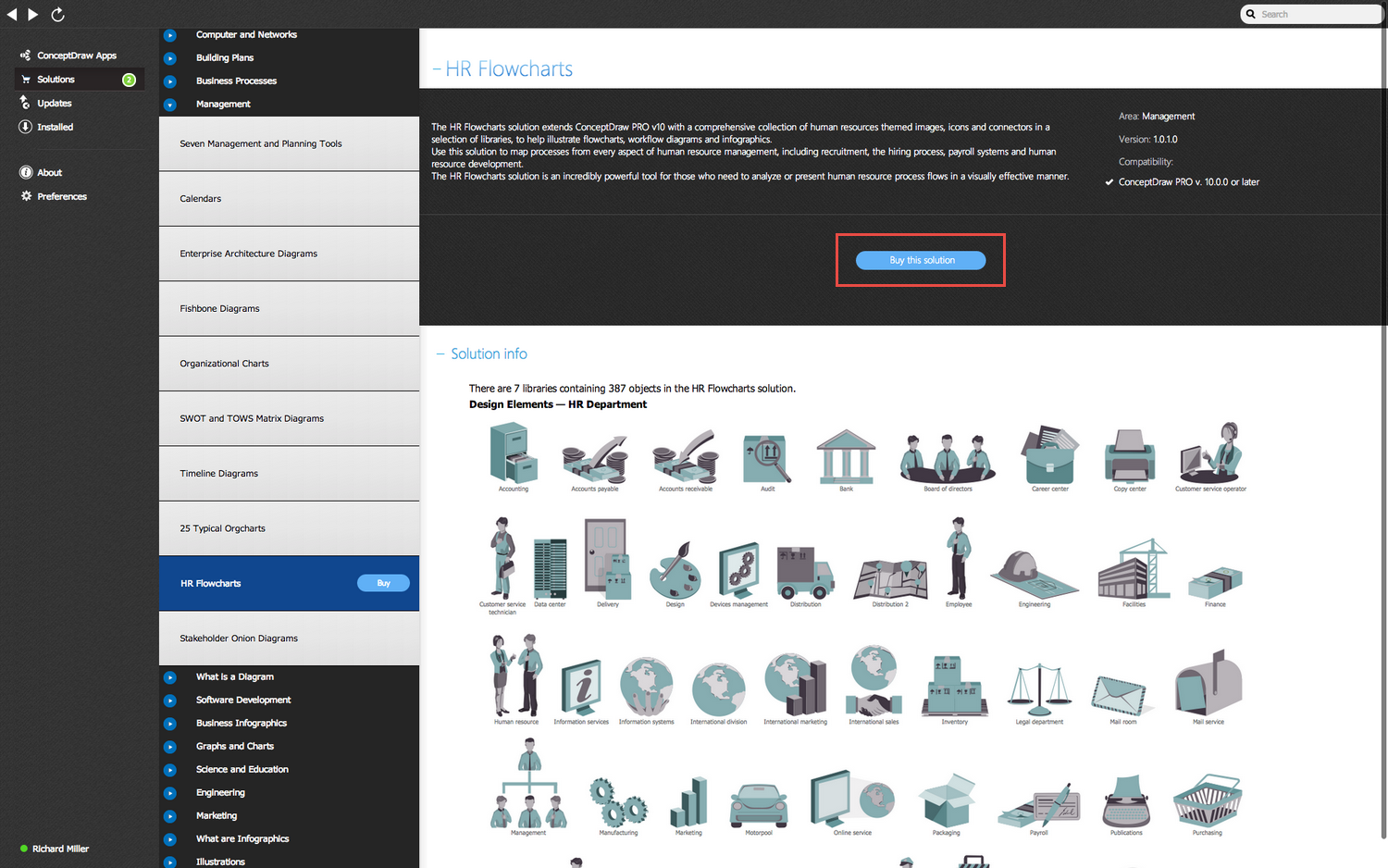
How to install
First of all, make sure that both ConceptDraw STORE and ConceptDraw DIAGRAM applications are downloaded and installed on your computer. Next, install the HR Flowcharts solution from the ConceptDraw STORE to use it in the ConceptDraw DIAGRAM application.
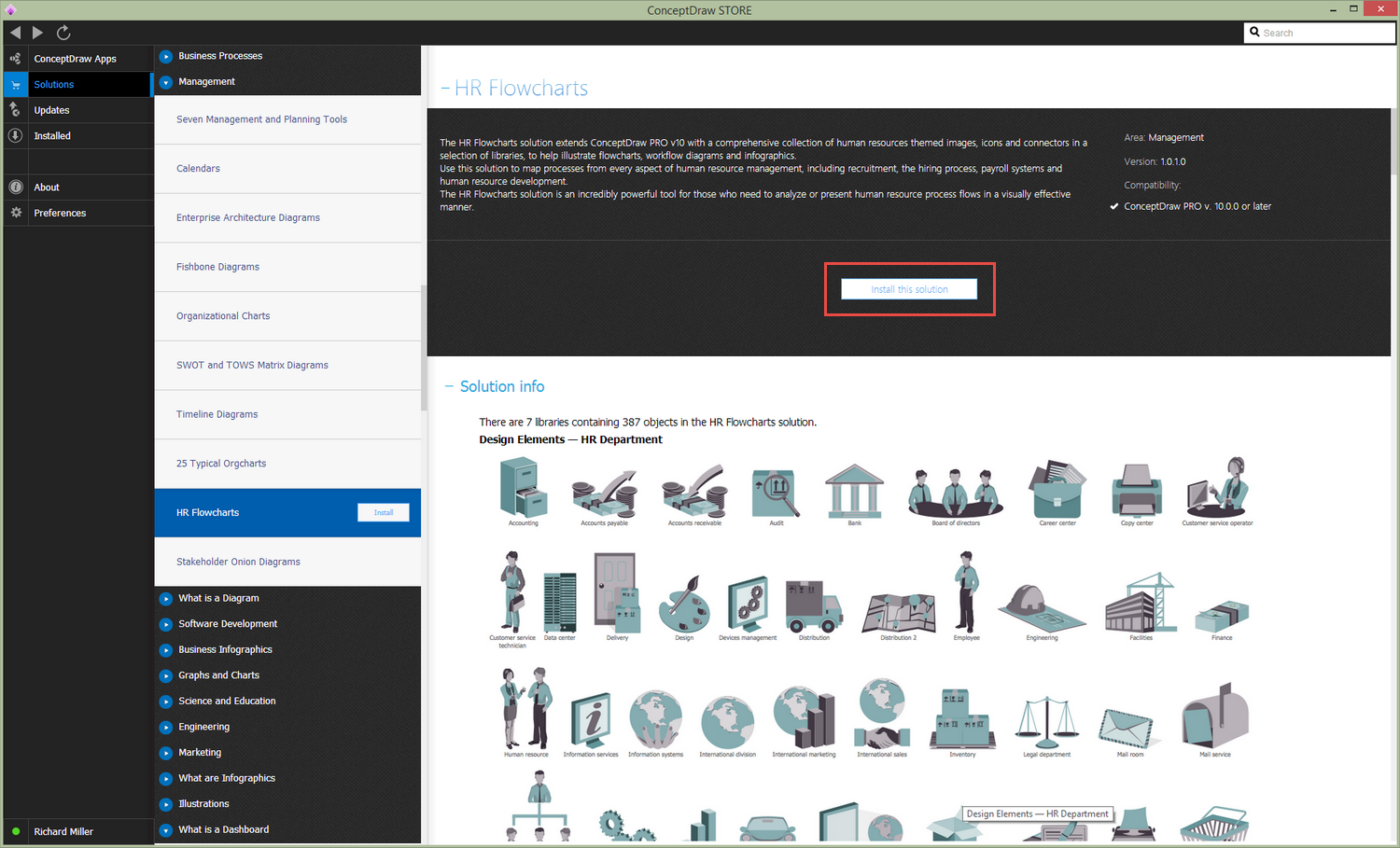
Start using
Start using the HR Flowcharts solution to make the professionally looking business planning diagrams by adding the design elements taken from the stencil libraries and editing the pre-made examples that can be found there.
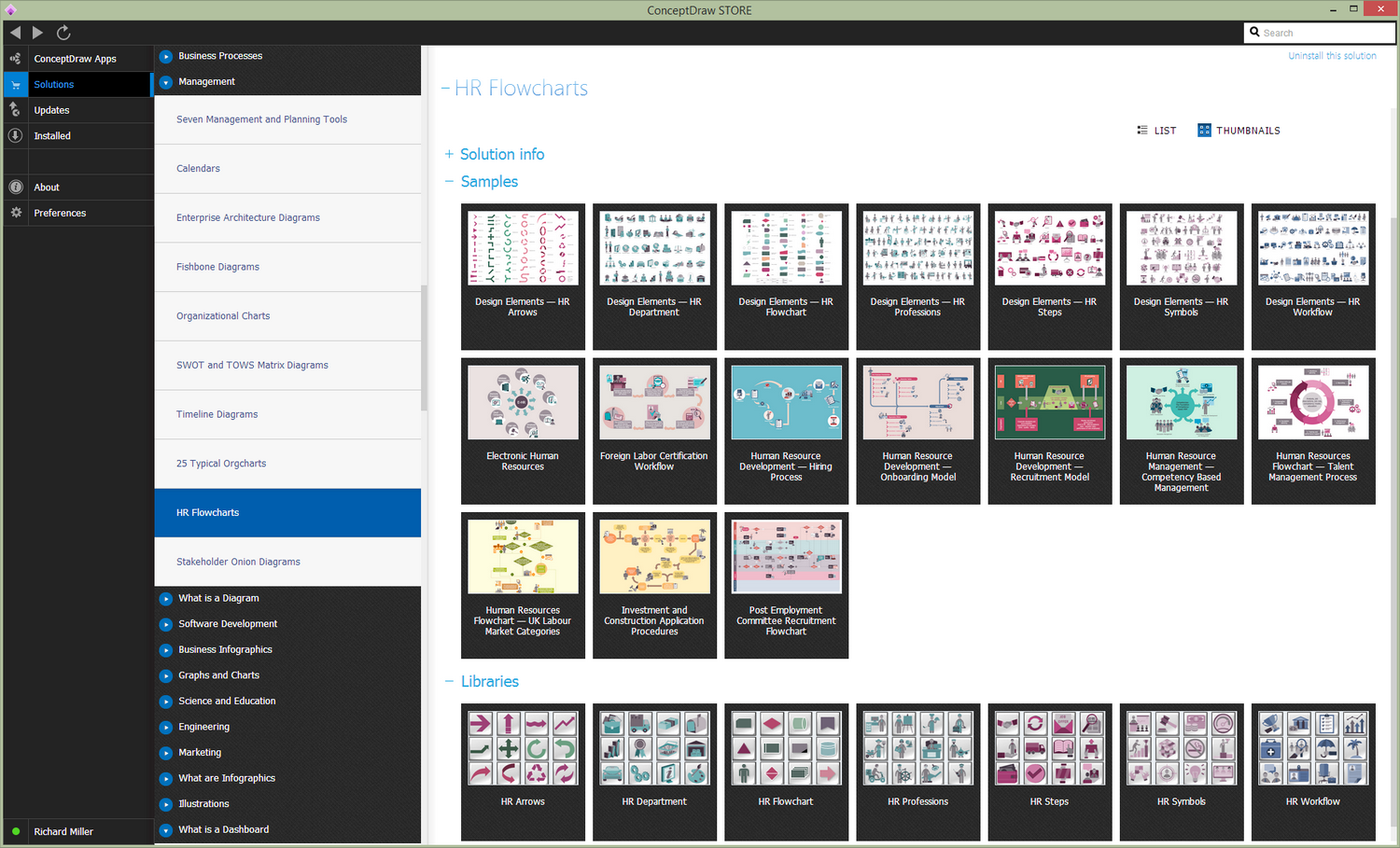
HR Flowcharting
Human resources is the term given to the people who make up the employee workforce of an organization or company. It was initially used simply as a synonym for manpower or labour; latterly, with the advent of globalization, a cottage industry has grown regarding human resource strategy, as a way of enhancing business value through management of the workforce.
The idea of human resource management (HRM, or HR) has its roots in the human relations movement of the early 20th century. Initially, the theory was applied more towards transactional processes, such as the administration of payments, holidays and benefits. Soon the focus would turn directly to the labor force, and the idea of workplace productivity began to take importance. A gradual change in HR policy meant that workers began to be view less as cogs in a machine, subject to unrealistic production demands, and more like an asset to the company, who can be trained and rewarded in order to provide even greater productivity in their work.
In modern times, the importance of HRM has been fully accepted and integrated into working life, to the point where the HR department of a business will often be one of the largest divisions in the company. At a macro-level, HR is responsible for leadership strategies and workplace culture, adhering to labor laws, health and safety, and security. On a more individual basis, they will deal with worker grievances, performance reports, and all steps of the hiring process.
This emphasis on employee satisfaction and training is not just an altruistic notion; it has become necessary because of the changing way of doing business. Companies have realized that constantly replacing a workforce is costly, inefficient and time-consuming — it's much more preferable to retain employee talent and knowledge, with a lower employee turnover. Business has changed in a global sense too — companies regularly trade internationally, with a wide range of partners, across different customs, cultures, and laws. As such, the modern HR department will find itself involved in the strategy behind mergers and acquisitions, diversity and inclusion, and industrial and labor relations.
It can be said that human resource management has four basic functions — staffing, training and development, motivation, and maintenance. The points below show some of the processes involved with each function.
Staffing
- Recruitment
- Interviewing
- HR networking
- Job descriptions
- Turnover reduction
- Requisition management
- Employment branding
- Candidate screening and assessment
- Recruitment scheduling
- Employment events management

Example 1. Human Resource Management
Training and Development
- Employee training
- Talent development
- Learning event management
- Performance management
- Succession planning
- Employee financial education
- Career planning
Motivation
- Payroll
- Benefits determination
- Health planning
- Retirement planning
- Employee compensation planning
- Total rewards management
- Wellness planning and maintenance
Maintenance
- Employee tax payment
- Time sheets
- Safety records
- Leave forms
- Insurance payment
- Absence management
- Claims and appeals management
- Personal financial planning
- Employees' dependents verification
- HR reporting
- Flexible spending account administration
- Employee records management
- Employee life events management

Example 2. Human Resource Development
With such a large and varied workload, it can be useful for an HR manager to design and create business process maps, that illustrate a specific process within the company. These can take the form of flowcharts, infographics or workflow diagrams. Specific diagrams work better with certain processes — for instance a flowchart acts a solution to a given problem; each step of the solution is represented by a box, from which multiple connections can flow dependent on the decision made at that step. An infographic is used as a graphical representation of data or knowledge, and act upon the human visual capability of spotting patterns and trends. All aspects of HR management can be mapped with their use, from macro to micro level — the versatility of flowcharts mean that one can be used to chart data flow through the payroll software system, or a more esoteric diagram can show HR management response and strategy in a given situation.
The advantages of business process mapping are numerous. They can be used as a plan, to try and stop initial mistakes with implementation; you see processes as part of a bigger picture, and can adapt them for certain scenarios; it can help you eliminate unnecessary steps, or speed up/automate parts of the process. Presenting data in visual form creates a unified message or strategy, and allows for easy distribution amongst team members.

Example 3. Human Resources Flowchart
With the new HR Flowcharts solution for ConceptDraw DIAGRAM, all these diagramming options and advantages are available to you. A comprehensive selection of predesigned vector stencils libraries allow you to create eye-catching infographics relating to any human resource management process. Also included are standardized flowchart notation symbols, meaning your diagrams will be relevant and understood by all business associates. We try to make things easy for you at ConceptDraw, so you will also find flowchart and workflow templates inside the solution to help you get started with your own design. Using the HR Flowcharts solution, you can create professional looking HRM business process diagrams in a matter of moments.